Do forest and ocean ecosystems have the capacity to recover what they lose due to deforestation and over fishing?

Whether on land or in oceans, living resources such as trees and fishes are being harvested by man excessively for timber and food respectively. Deforestation (loss of forests) causes loss of animals and plants at a rate 3 or 4 times higher than their natural death rate while over fishing causes the depletion of nearly 90% of the world’s marine fish stocks (fish-able populations). For instance, about 60,000 tons of the Atlantic Blue fin tuna are now being harvested whereas the maximum sustainable yield (allowed catch) of this fish species is estimated to be around 7500 tons. This will definitely affect the ability of the tuna stock to replace its lost fishes in the long term, causing depletion and perhaps extinction of the fish stock.
Deforestation (loss of forests) causes loss of animals and plants at a rate 3 or 4 times higher than their natural death rate while over fishing causes the depletion of nearly 90% of the world’s marine fish stocks(fishable populations). For instance, about 60,000 tons of the Atlantic Blue fin tuna are now being harvested whereas the maximum sustainable yield (allowed catch) of this fish species is estimated to be around 7500 tons. This will definitely affect the ability of the tuna stock to replace its lost fishes in the long term, causing depletion and perhaps extinction of the fish stock.
How do the forest or ocean ecosystems cope with this exploitation? Do they have the capacity or resilience to sustain themselves?
The productivity of a forest or ocean community (group of populations of different species living in a particular area) contributes to the resilience of ecosystems. Productivity is the rate at which energy is added to the body of an organism in the form of biomass. Thus, one gram of average plant and animal biomass (wet weight) has about 2 and 2.5 kcal energy respectively. The total ecosystem productivity includes both primary (by plants) and secondary productivity(by animals).
Biomass is the weight of living biological organisms in a given area or ecosystem at a given time. For deforestation or fishing to be sustainable (that is the lost biomass of trees or fishes is replaced) the rate at which trees or fishes are removed should be equal to the rate at which new biomass is added to the population through reproduction (birth of new young individuals) or growth (increase in size and weight).
Both animals and plants are organized and require energy to maintain their organization by doing work. Sunlight is the ultimate source of energy for all living organisms. Ecosystems maintain a constant inflow of energy and matter and a constant outflow in the form heat and wastes. Energy enters the system through fixation by producers by a process called photosynthesis and then is transferred to plant eaters called herbivores which are in turn eaten by carnivores.
This flow of energy along the ecosystem through a series of steps eating and being eaten known as a food chain.

The productivity to biomass ratio also known as the residence time gives us a clue to how well a particular ecosystem can respond to human exploitation.
Thus the ratio of Net Primary Productivity (kilogram of dry matter produced per area per year to the Biomass( kilogram matter per area) is very low in forests and very high in aquatic communities(on average 0.042 for forests and 17 for aquatic communities).
The plants require sun light, carbon dioxide, nutrients and water to carry out photosynthesis or fixing of carbon as food matter or carbohydrates. On land sun light, gases and nutrients are unlimited though water is. In comparison in the oceans though water is plenty, sun light, nutrients and gases are limited due the depth of the water column which slows down penetration of light, dissolution of gases and the upwelling of nutrients released from dead matter at the depth of the ocean. The primary production is therefore greater in forests than in the ocean.
However the flow of energy through the forest ecosystem is slower than that in the ocean ecosystem causing differences in the rates of fixation of energy in the form of biomass in trees and fishes. The main reasons are as follows:
- the primary production in the trees are not fully available to the herbivores due to the presence of undigestible bark and root material which do not photosynthesize or are slow to decompose. In contrast, phytoplankton, the plants of the sea have very little hard structures and are easily assimilated by the herbivores of the sea.
- only 10 % of the energy fixed by the trees flows in to herbivores because, of the energy acquired from photosynthesis, about 90% is spent on metabolism and excretion.The remaining 10% is converted in to biomass and is made available for the herbivores.
- Similarly from the herbivores only 10% energy is passed on to the carnivores.
- Furthermore, the forests are full of warm blooded mammals which require a lot of energy to maintain their body heat in contrast to ocean animals which are cold blooded( body temperature changes with that of the environment).

Rain forest food web 
Ocean food web
- Hence, a much reduced energy flow is noticed in the forest ecosystem when compared to the ocean ecosystem resulting in a reduced fixation of energy in the form of biomass in the forests.
The residence time or the ratio of productivity to biomass refers to the time taken for the energy to flow through the ecosystem.
The lesson of this article is therefore if you cut trees it will take a long time for the tree population to replace it self naturally whereas if you take fishes out of the sea the capacity of their population to replace them is greater.
Vino Santhanam


